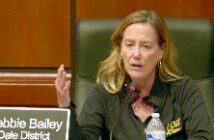A survey conducted this past spring by the Virginia Association of School Superintendents (VASS) revealed that drastic reductions in state funding for public education and maximum efforts by localities to replace lost funds have pushed Virginia’s schools to the limits of their human and financial capacity in their attempts to meet today’s expectations and serve the needs of students. A recent Joint Legislative Audit and Review Committee (JLARC) reported that Virginia relies more on localities to fund K-12 than other states and that Virginia’s localities pay the highest share of total K-12 spending in the Southeast region. The JLARC report further confirmed that Virginia school divisions are spending less per student than they did a decade ago and that as a result they are on the verge of becoming less effective instructionally.
Yet Chesterfield County Public Schools (CCPS) touts its frugal management of funds per student. According to the Federal Education Budget Project $9,508 per student is budgeted per student, which is 18 percent less than the state average.
Since the beginning of the recession in 2008, the state has reduced its share of funding for public education by approximately $1 billion. State per pupil funding for K-12 education has decreased from $4,275 per student in 2009 to $3,655 per student in 2015. Localities have not only attempted to cover this loss, but they have also attempted to finance increased demands placed on them by higher academic standards, greater enrollments, and larger numbers of students in poverty as well as larger numbers of students from diverse backgrounds.
State funding reductions since 2009 have required superintendents and school boards to drastically reduce staff, increase class sizes, eliminate co-curricular and extra-curricular programs, and cut spending on professional development. The VASS survey shows that:
- 111 of the 132 school districts had a reduction in state funding per pupil since 2008-09 by an average of $593.00.
- 52 of the 132 school districts had a reduction in local funding per pupil since 2008-09 by an average of $1,503.00.
- 92 percent of Virginia’s school districts have cut staff to accommodate state funding reductions. Over 10,000 positions have been eliminated, with over half of those being teaching positions.
- 71 percent of the school districts have increased class sizes. The largest class sizes reported averaged 25.7 at the elementary level, 28.7 at the middle school level, and 29.8 at the high school level.
- 52 percent of the school districts reported that they have reduced co-curricular programs such as fine arts, foreign language, physical education and career technical education. A total of 88 career technical education programs have been eliminated at a time when workforce readiness is a higher priority than ever.
- 29 percent of the school districts have reduced extra-curricular programs such as academic clubs, student clubs and athletics. For many students, these programs are what make schooling relevant to their lives.
- 76 percent of the school districts have cut spending for professional development at a time when more demands are placed on teachers to be trained in various pedagogical skills.
- 23 percent of Virginia’s school districts have been forced to close schools for financial reasons, which has had a negative impact on the culture and quality of life in those divisions.
Virginia’s school divisions have accomplished a lot with very little according to VASS Secretary-Treasurer and Chesterfield County Schools Superintendent Marcus Newsome. “Despite the reductions in state funding during the past few years, we have managed to enhance our students’ performance overall on standardized tests through some increased local funding, greater creativity, and improved efficiency. However,” he emphasized, “most of my colleagues would agree that this process is unsustainable; to expect this trend to continue, while implementing another round of reforms, is unrealistic.”
Details: www.vassonline.org

